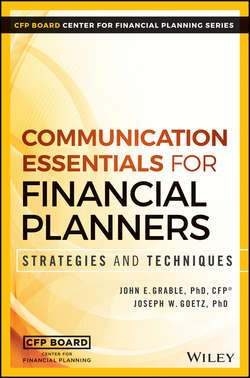Communication Essentials for Financial Planners

Реклама. ООО «ЛитРес», ИНН: 7719571260.
Оглавление
Grable John E.. Communication Essentials for Financial Planners
Preface
WHY THIS BOOK
COMMUNICATION: WHAT IS IT?
BUILDING CLIENT TRUST AND COMMITMENT
MODELS OF COMMUNICATION
FINANCIAL PLANNING COMMUNICATION AND COUNSELING SKILLS FRAMEWORK
SUMMARY
Acknowledgments
How to Use This Book
Introduction
CHAPTER 1. An Introduction to Applied Communication
INTRODUCTION
FINANCIAL PLANNING OUTCOMES
COMMUNICATION DEFINED
THE THEORY OF COMMUNICATION
THE IMPORTANCE OF FEEDBACK
CONCLUSION
SUMMARY
CHAPTER 2. Structuring the Process of Interpersonal Communication
INTRODUCTION
SOCIAL PENETRATION THEORY
ORIENTATION
EXPLORATION
AFFECTIVE EXCHANGE
STABLE EXCHANGE
RELATIONSHIP BENEFITS AND COSTS
ACCOUNTING FOR STRESS
BUILDING CLIENT TRUST: AN APPRECIATIVE INQUIRY EXAMPLE
SUMMARY
CHAPTER 3. Structuring the Process of Communication through the Office Environment
INTRODUCTION
IDENTIFYING TARGET CLIENTELE
UNDERSTANDING THE OFFICE ENVIRONMENT
STRESS AND COMMUNICATION: BRINGING THE PIECES TOGETHER
SUMMARY
CHAPTER 4. Listening Skills
PAYING ATTENTION TO THE CLIENT
ATTENDING TO WHAT IS SAID
INTERPRETING WHAT IS HEARD
TRANSFERENCE AND COUNTERTRANSFERENCE
PASSIVE VERSUS ACTIVE LISTENING AND RESPONDING
SILENCE: A STRESSFUL TIME FOR CLIENT AND FINANCIAL PLANNER
RESPONDING TO “I DON’T KNOW”
SUMMARY
CHAPTER 5. Questioning
INTRODUCTION
OPEN-ENDED QUESTIONS
CLOSED-ENDED QUESTIONS
CHOOSING BETWEEN OPEN AND CLOSED-ENDED QUESTIONS
QUESTION TRANSFORMATIONS
SWING QUESTIONS
IMPLIED AND PROJECTIVE QUESTIONS
SCALING QUESTIONS
SUMMARY
CHAPTER 6. Nondirective Communication
WHY NONDIRECTIVE COMMUNICATION?
OUTCOMES ASSOCIATED WITH NONDIRECTIVE COMMUNICATION
CLARIFICATION
SUMMARIZATION
REFLECTION
PARAPHRASING
STYLES OF PARAPHRASING
SUMMARY
CHAPTER 7. Directive Communication
DIRECTION: THE ESSENCE OF FINANCIAL PLANNING
INTERPRETATION
REFRAMING
EXPLANATION
ADVICE
SUGGESTION
URGING
CONFRONTATION
ULTIMATUM
SUMMARY
CHAPTER 8. Trust, Culture, and Communication Taboos
UNDERSTANDING A CLIENT’S CULTURAL ATTRIBUTES
INTERPERSONAL PREFERENCE
RISK MANAGEMENT
CULTURE AND TRUST
COMMUNICATION TABOOS
A CULTURAL EXAMPLE
SUMMARY
CHAPTER 9. Politeness and Sensitivity in Communicating with a Broad Range of Clients
THE POWER OF LANGUAGE
POLITENESS
POLITENESS THROUGH INCLUSION VERSUS EXCLUSION105
SENSITIVITY
LANGUAGE SENSITIVITY
SUMMARY
CHAPTER 10. Financial Planning – A Sales Perspective
SALES MODELS
THE CHALLENGER MODEL
THE CONSULTATIVE MODEL
MANIPULATION VERSUS PERSUASION
CONSULTATIVE SELLING AND COMPENSATION
UNDERSTANDING CLIENT BEHAVIOR
DEALING WITH “NO”
THE ETHICS OF SELLING
SUMMARY
Solutions
About the Authors
ABOUT THE EDITOR
About the Companion Website
Отрывок из книги
The purpose of this book is to provide financial planners with insights on how they can improve their communication and counseling skills. The approach presented in this book is based on helping financial planners develop, practice, and use skills associated with the formal and informal sharing of information between a client and the financial planning professional in an empathic manner that enhances the client–financial planner relationship.2
This book serves as a valuable resource for students and professionals alike. The ineffable importance of consistent and effective communication with clients is widely acknowledged by experienced financial planners. At the same time, few planners have implemented systems within their firms (or personal professional development plans) to increase knowledge and hone skills associated with client communication! This book provides professional financial planners, as well as the leadership within financial planning firms, with a blueprint for taking their client communication to the next level. Inarguably, increased sophistication in client communication translates to higher client retention and a more effective financial planning process. Thus, the ROI on time allocated to toward communication skill development is quite high.
.....
A financial planner must be able to communicate effectively to bring these five factors together. For those financial planners who want to build client trust and commitment, developing and practicing outstanding client communication and counseling skills is the most effective path to this outcome.13
Researchers working over the past half century have built numerous models that help explain the process of communication. Almost every model extends the basic rhetorical framework originally proposed by Aristotle, as shown in Figure P.1.
.....